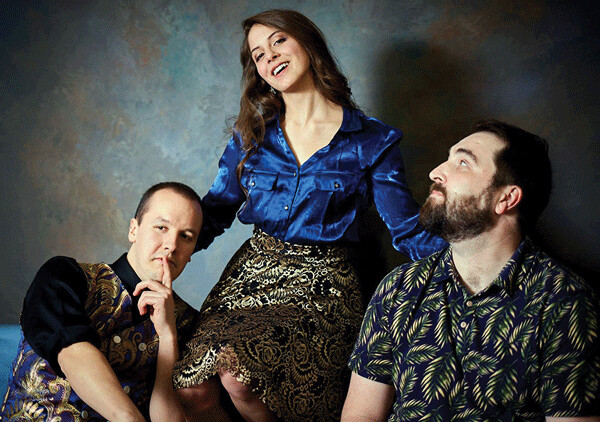News & Articles
Browse all content by date.

For centuries, humanity has struggled with one burning quandary: what to do with the xylophone? It’s great for skeleton dances and kooky moments in old TV shows. It’s been useful in classical numbers like “Saber Dance” and “Gassenhauer.” (You know, the theme from the movie “Badlands.”) Frank Zappa used it for cheap larfs but it was more unlistenable than funny, not that Frank cared whether you liked it or not. Gotye used it in “Somebody That I Used to Know,” which is now Some Song That I Used to Like, until I really started noticing the xylophone.
For the most part, no one has figured out how to overcome the fact of life that dooms the xylophone to wretchedness: We were all forced to play it in elementary school and never wanted to hear it again.

Mikayla Haynes must have been the one kid in class who loved the xylophone and stuck with it up through college, when she studied classical percussion at the University of Wisconsin-Superior and encountered fellow self-described music nerd Cory Coffman. They brought in bassist Matt Mobley, an experienced session player, and thus formed The Cuckoo Bees. Why name themselves after a kleptoparasitic bug that lays eggs in the nests of other bees in the manner of cuckoo birds? Probably because the name, like the xylophone itself, sounds eccentric.
Percussion is their thing, yet the album is more for listening than dance. Just as it gets a groove going, it changes rhythm. They’re into experimenting rather than churning out potential hits, and the songs go all over the place in terms of style. Nary a breath of blues, funk or hip hop, alas, but that’s their artistic choice. There’s so much variety, you’re bound to find something to like or dislike.
Haynes uses the xylophone (actually the marimba, but what’s the difference? I’m not sure) to blissful effect in “Brief History of a Star,” a three-part New Age instrumental that makes up tracks 1, 7 and 14. “Yep, it’s about aliens and space stuff,” according to the liner notes.
She also uses it for macabre effect in two minor-key vaudeville songs. One is “No Sad Song,” actually the second track on the album and the first with vocals. Coffman starts off, “I’ve been singing songs around this place for months, drinking shit and puking out my guts.” How will that go down when they perform their next scheduled show in a church coffee shop? (The Jesus Fellowship of Believers Church website advertises the event with a clip from that song, but not that line.) Will they change or hum the lyrics, or stick to their guns like Jim Morrison on the Ed Sullivan Show, gosh darn the consequences?
Even when he’s swearing (only three times, but enough to get the album an “explicit” warning on Amazon) Coffman has a cheery, earnest voice reminiscent of 1970s sunshine-pop stars. This works best in the bubblegummy, wonderful “Midnight Calling.” Haynes sings “bop, bop, bop” in the background while playing the glockenspiel, which is like the xylophone but with steel instead of wooden bars. (I’d forgotten that info from elementary school and had to look it up.) The lyrics, however, are bittersweet and haunting, about a love five years past: “I still keep a picture of you on a wall inside my head.”
“Humblin’ Cold” is the other dark vaudeville song. Musically it seems the perfect anthem for this winter, but it’s not about the weather. Instead, it’s got cool lyrics about the highway to hell: “You’re running with the pack now for some time / You got new claws and horns behind your ears / Welcome to this new place, have you ever been so alive?” We know this story won’t end well, but I’m not sure this band will be a good influence on the kids at Jesus Fellowship.
“Raspberry Seeds” is a guitar-strumming song about rambling. (“Just a pocketful of daydreams and a hint of weary on my face.”) “I’ve Been Thinking” is in ‘20s jazz style with Coffman and Haynes scatting “be bop a boo bop” as a clarinet plays, then midway it switches to reggae. “Simple Song” is anything but, a tricky contemporary jazz tune. “Dream” is the closest to rock, with fuzzy electric guitar riffs and drums. The title track, the Low-like “Weeping Willow,” builds slowly and powerfully. It’s very serious, which stands out since everything else is served with a wink.
As to be expected with an experimental album, there are missteps. One is “Woodblind,” which is fine in concept, a tip of the hat to another local band of the title name, whose founding member owns Beaner’s Central, which has provided a stage for the Bees. But the music is ska lite and the xylophone too cutesy. “Castles in the Air” is ghastly imitation Afro-world beat. The album closes with “Dub Thinkin’,” a brief snippet of a song. I’m not sure why it’s here, other than to give us a glimpse of yet another genre the Bees work in.
Give them credit, they got the music, lyrics and production down tight. But if they’re going to experiment, they might aim for something we’ve never heard before rather than genre-hopping. But then again, first album, okay? Did David Bowie reinvent the wheel on his first album? Remember the laughing gnome song? Yet he went on to be David Effin Bowie. So dare I say it? Get a buzz on with the Bees.
The Cuckoo Bees’ next show is Friday, March 8, 7 p.m. at Raven Fed in the basement of Jesus Fellowship of Believers Church, 30 N. 58th St. W. in Duluth. The album is available on iTunes, Amazon and Spotify.
| Tweet |


